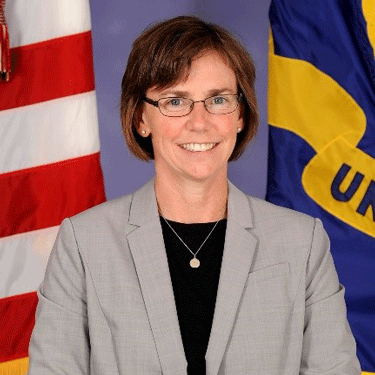Many of the major building blocks of the Department of the Navy’s new Navigation Plan 2022 are all contained in and around technology.
From digital integration to digital modernization to creating a decision advantage, the three priorities build on each other to make the DoN more agile, better linked to its fellow services, agencies and allies, and more lethal to take on near peer adversaries.
Digital Modernization Strategy
Our digital modernization strategy is really focused on how do we become a software dominant naval force? If we want to maintain our maritime advantage, it is really critical in this dynamic security environment that we become a software dominant force.
Kelly McCool
Director, Digital Warfare Office, Navy N9
“Our digital modernization strategy is really focused on how do we become a software dominant naval force? If we want to maintain our maritime advantage, it is really critical in this dynamic security environment that we become a software dominant force,” said Kelly McCool, the director of the Digital Warfare Office for the Navy N9, during the discussion Modern Government: Digital Transformation: Data, Collaboration and Insights. “Really, it’s about modernizing our legacy software approaches which have these entanglements with our hardware, which makes it hard to upgrade our software. We have to break down those dependencies to free us for more agile software development, and hardware upgrades on a different pace.”
By creating this new software environment, the DoN will modernize its systems and networks no matter the platform, air, sea or shore, more quickly. And those two concepts will lead to the department’s ultimate goal, speed to decisions.
Becoming software dominant
“The idea here is, and this is a central imperative in the CNOs NAVPLAN, if we have digital integration; we can communicate across our forces, and we have this modernized software where we can release software updates quickly, then now we have the building blocks to really measure our decision speed,” McCool said. “We see ourselves as a significant part of the integrated deterrent strategy, which is a key part of the national deterrent strategy.”
To become a software dominant force, the Department of Navy launched Project Overmatch in 2021. It’s part modern software factory, part the Navy’s piece of the Joint All-Domain Command and Control (JADC2) program and part classified next generation technology.
The Department of the Navy is expecting to accelerate the initiative in fiscal 2023 as it asked Congress for $195 million, which is $122 million more than it received in this year.
“Project overmatch is really at the forefront of how we do DevSecOps with a software delivery pipeline that uses agile software development capabilities. There’s uniqueness though because in other DevSecOps environments, you do the development in a way where you’re always connected to the cloud or you’re always connected to the web, we, obviously with our forward platforms, aren’t going to have that connection,” McCool said. “We will have a hybrid situation where we do our development in an agile way, and we’ll have the capability to upgrade our software over the air while we’re deployed. There’s a lot of learning that we have to grow into and Project Overmatch is really at the forefront of delivering that capability.”
Unusual to change applications
McCool said the DoN will deliver the minimum viable product (MVP) capability to a single carrier strike group next year. In the meantime, her office is ensuring the crew is trained to use the capability, particularly around network improvements and creating decision support tools.
“We’ve had some learning there too. Our traditional training methods of using PowerPoint to describe what a tool does is not really the most effective way to train some of our young sailors,” she said. “We’re now using a live sandbox environment where you can see the touch and the feel of the tool as well as how it really would operate. It’s a little bit more intuitive.”
Project Overmatch’s DevSecOps capability will be a major change for the DoN. McCool said typically the service doesn’t change software for a carrier strike group when it is out of port unless they absolutely have to because of concerns about the impact the change would have on the mission.
“This is an area that as the system is deployed that we’re going to be exploring with the fleet as operational capabilities and operations allow and bandwidth allows, we’ll be exploring those over the air updates and what makes sense. What’s that right balance?” she said. “What is unique about Overmatch is this capability to deploy to the fleet, but in a development sense, there will be development going on shore based and we’ll be continuing to upgrade tools and the analytic capabilities. I think there’s an opportunity there for maybe common practices and common use cases. But I think we’re a little too premature for that conversation yet.”
Need to make sense of the data
Along with Project Overmatch, McCool said another key initiative around digital integration is the DoN’s data strategy, ensuring it has the ability to move data to and from the tactical edge.
Priorities for Digital Modernization
Project overmatch is really at the forefront of how we do DevSecOps with a software delivery pipeline that uses agile software development capabilities. There's uniqueness though because in other DevSecOps environments, you do the development in a way where you're always connected to the cloud or you're always connected to the web, we, obviously with our forward platforms, aren't going to have that connection.
Kelly McCool
Director, Digital Warfare Office, Navy N9
“The fact that we can improve how much data gets to the warfighter doesn’t necessarily mean they’re going to be able to make better quicker decisions with it. In fact, more data can often cause decision paralysis and especially when that data is confusing or the environment is just overwhelming,” she said. “We need the right tools and the right algorithms to really simplify what is presented to the fleet. What we’re focused on is what are the right decisions that need to get made and by whom? Where is the decider physically located? Are they on an aircraft carrier? Are they under water in a submarine far forward? Are they on a destroyer? Or are they on a headquarters facility in the states? That really matters. So working with the fleet to have that deep knowledge of how the Navy plans and executes, that’s really where we’re going to focus on those decision support tools to eliminate those friction points. That’s really where we think we’ll get to the better, faster decisions.”
She added the DoN will have to rely on artificial intelligence and machine learning capabilities to help sift through the data. This includes moving AI tools to the tactical edge, especially as the service relies on unmanned platforms more and more.
“One of our key innovation engines is the unmanned task force as well as Task Force 59, which is our fleet operational battle lab. In that regard, they’re working very closely with industry and with emerging industry players in this space, not necessarily your traditional DoD primes. What they’re really trying to get after is ‘how do I use AI and ML in in smaller unmanned platforms so that you’re synthesizing the data much more quickly?’ she said. “You’re getting to reduce the workload of the operator and you’re optimizing your decisions. This tactical edge for unmanned systems and manned unmanned teaming is an area that we’re highly interested in and we’re going to need to advance here in the future.”
McCool said all of these efforts are leading the Department of the Navy to an end goal that isn’t just digital modernization, digital integration or even speed to decisions.
“How do we how do we get to a place where as our CNO puts it, we can have a move countermove capability? We deliver a capability to the fleet, but then expect that the adversary will have some sort of unexpected reaction, or counter and us having ability to react very quickly,” she said. “That’s the most important thing that we’re really trying to drive that as we go to this digital modernized world.”
Listen to the full show:
Copyright
© 2024 Federal News Network. All rights reserved. This website is not intended for users located within the European Economic Area.






